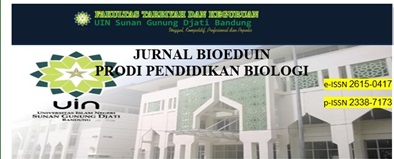VIDEO BLOG (VLOG) SISTEM REPRODUKSI SEBAGAI MEDIA PEMBELAJARAN BIOLOGI
DOI:
https://doi.org/10.15575/bioeduin.v9i2.6222Keywords:
Media, Vlog (Video Blog), Reproduction SystemAbstract
Global demands require the world of education to always develop technology in an effort to improve education, promote the use of information and communication technology for the world of special education in the learning process. The use of technology media that is done correctly will be able to make learning activities and obtain information and knowledge more effective and efficient. This study aims to produce a product that consists of vlog (video blog) -based learning media in the payment system material for free socialization material. This type of research is Research and Development (R & D), using the ADDIE Model (Analysis, Design, Develop, Implement, Evaluate). Before the product is developed, a scenario is first made. After the product is developed it is validated by material experts, media experts and biology teachers, then implement to students. The subjects of this study were 32 students from XI MIPA class SMA N 2 Slawi and 17 students from class XI MIPA MA Uswatun Hasanah. The validation test results show that the vlog (blog video) is suitable for use with the appropriate revision of the advice given The percentage of eligibility of material experts is 79%, media experts are 85%, biology teachers are 84% and students are 88%.References
Anderson, Terry. 2008. The Theory and Practice of Online Learning. Athabasca University. AU Press
APJII. 2017. Penetrasi dan Perilaku Pengguna Internet.
Branch, R. M. (2009). Instructional Design-The ADDIE Approach. New York: Springer.
David, Eribhka Ruthellia, dkk. 2017. Pengaruh Konten Vlog dalam Youtube terhadap Pembentukan Sikap Mahasiswa Ilmu Komunikasi Fakultas Ilmu Sosial dan Politik Universitas Sam Ratulangi. Acta Diurna. Volume VI. No. 1.
Francis, Dennis A. 2009. Sexuality Education in South Africa: Three Essential Question. Jurnal of Educational Development. Vol. 12. No. 003
Ihsan, Fuad.2008. Dasar-dasar Kependidikan. Jakarta: Rineka Cipta
Ihsan, Fuad.2008. Dasar-dasar Kependidikan. Jakarta: Rineka Cipta
Infodatin. Pusat Data dan Informasi Kementrian Kesehatan RI. ISSN 2442-7659
Marmi. 2013. Kesehatan Reproduksi. Yogyakarta: Pustaka Pelajar
Mercer, N. 2017. Dialogue, thinking together and digital technology in the classroom: Some educational implications of a continuing line of inquiry. International Journal of Educational Research . 08.07
Murati, Rabije. Ceka, Ardita. 2017. The Use of Technology in Educational teaching. Jurnal of Education and Practice. Vol. 8. No. 6
Murwati, Katarina. 2014. Penggunaan Metode Diskusi Kelompok Untuk Meningkatkan Hasil Belajar Siswa Dalam Pembelajaran IPA di SD. FKIP Universitas Tanjungpura Pontianak
Nadirah, Sitti. 2017. Peranan Pendidikan Dalam Menghindari Pergaulan Bebas Anak Usia Remaja. Musawa Vo. 9 No. 2
Nuryoto, Sartini dan Aviatin, Tina. 2002. Hubungan Antara Komunikasi Efektif Tentang Seksualitas Dalam Keluarga Dengan Sikap Remaja Awal Terhadap Pergaulan Bebas Antar Lawan Jenis. Jurnal Psikologi No. 2, 124 – 139
Priana, Rhony Yudhi Septa. 2017. Pemanfaatan Vlog sebagai Media Pembelajaran Terintegrasi Tekologi Informasi. ISBN 978-602-19411-2-6
Ruthellia dkk, 2017. Pengaruh Konten Vlogdalam Youtubeterhadap Pembentukan Sikap Mahasiswa Ilmu Komunikasi Fakultas Ilmu Sosial dan Politik Universitas Sam Ratulang, e-journal “Acta Diurna†Volume VI. No. 1. Tahun 2017
Pribadi, Beny A. 2017. Media dan Teknologi dalam Pembelajaran. Jakarta: Kencana
Soyomukti, Nurani. 2010. Teori-teori Pendidikan. Yogyakarta: Arruz Media
Sugiyono. 2017. Metode Penelitian dan Pengembangan. Bandung: Alfabeta
Syukur, Fatah. 2008. Teknologi Pendidikan. Semarang: Rasail Media Grup
Wanyonyi, Hellen Sitawa. 2014. Youth Sexual Behaiour and Sex Education. Jurnal of Education and Research. Vol. 2. No. 3
Downloads
Published
Issue
Section
License
Authors who publish in Jurnal BIOEDUIN agree to the following terms:
- Authors retain copyright and grant the journal right of first publication with the work simultaneously licensed under a Attribution-ShareAlike 4.0 International (CC BY-SA 4.0) License that allows others to share the work with an acknowledgment of the work's authorship and initial publication in this journal.
- Authors are able to enter into separate, additional contractual arrangements for the non-exclusive distribution of the journal's published version of the work (e.g., post it to an institutional repository or publish it in a book), with an acknowledgment of its initial publication in this journal.
- Authors are permitted and encouraged to post their work online (e.g., in institutional repositories or on their website) prior to and during the submission process, as it can lead to productive exchanges, as well as earlier and greater citation of published work (See The Effect of Open Access).

